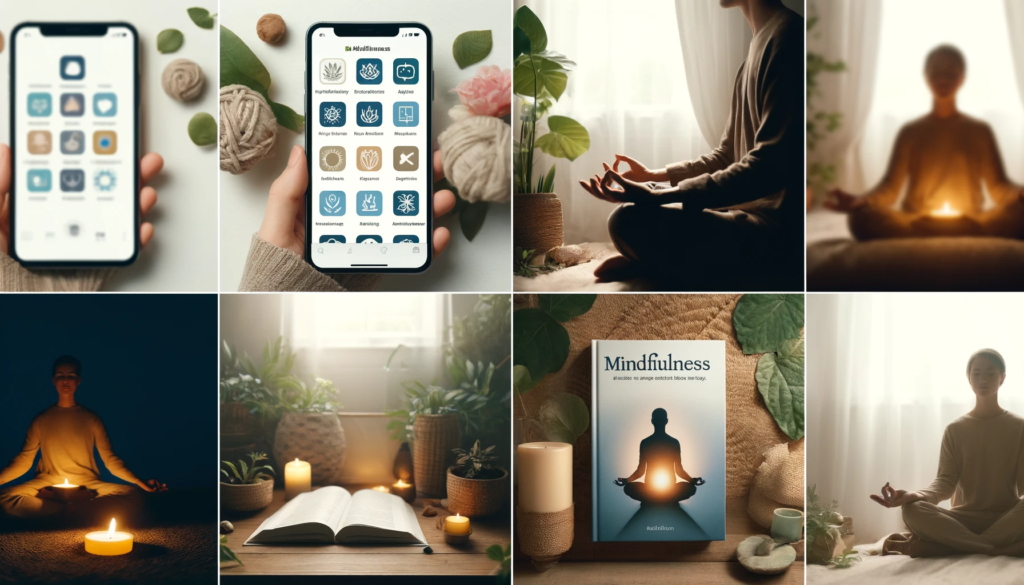Did you know that practicing mindfulness can significantly reduce stress and improve overall well-being? In today’s fast-paced world, where distractions are everywhere, mindfulness offers a powerful tool to help you stay present and connected to the moment. Whether you’re dealing with daily stressors, seeking to enhance your mental clarity, or looking to improve your emotional health, mindfulness can be a game-changer.
What is mindfulness, and why is it so important? Mindfulness is the practice of being fully present and engaged in the current moment, without judgment. It involves paying attention to your thoughts, feelings, and sensations in a way that fosters a greater sense of awareness and calm. The origins of mindfulness can be traced back to ancient Buddhist practices, but in recent years, it has gained widespread popularity in the West, thanks in part to influential self-help books and scientific research highlighting its benefits.
The importance of mindfulness cannot be overstated. Numerous studies have shown that regular mindfulness practice can lead to a host of benefits, including reduced anxiety and depression, improved focus and concentration, better emotional regulation, and even enhanced physical health. For instance, a study published in the journal Health Psychology found that mindfulness can improve immune function and reduce markers of inflammation, which are linked to chronic illnesses.
In this article, we will explore essential mindfulness techniques from some of the top self-help books, providing you with practical tips and insights to help you integrate mindfulness into your daily life. Whether you’re new to mindfulness or looking to deepen your practice, these techniques will offer valuable guidance on your journey towards greater mental and emotional well-being.
Let’s dive in and discover how mindfulness can transform your life!
What is Mindfulness?
Mindfulness is a mental practice that involves focusing your attention on the present moment, while calmly acknowledging and accepting your feelings, thoughts, and bodily sensations. This practice has its roots in Buddhist traditions but has become increasingly popular in Western psychology and self-help practices. The goal of mindfulness is to cultivate a heightened awareness of the present moment, leading to a more balanced and focused state of mind.
Definition and Origins
Mindfulness can be defined as the quality of being fully engaged and aware of where we are and what we’re doing, without being overly reactive or overwhelmed by what’s going on around us. This concept is not just about relaxation but involves a deliberate focus on the present moment, often achieved through practices such as meditation, breathing exercises, and mindful movement.
The origins of mindfulness can be traced back to ancient Buddhist practices, where it was a fundamental component of the path to enlightenment. The term itself is a translation of the Pali word “sati,” which means “awareness” or “attention.” While mindfulness has deep spiritual roots, its modern application in psychology and wellness is largely credited to Jon Kabat-Zinn, who developed the Mindfulness-Based Stress Reduction (MBSR) program in the late 1970s.
Importance of Mindfulness
The importance of mindfulness lies in its ability to foster a greater sense of awareness and presence, which can lead to numerous mental and physical health benefits. Here are some key reasons why mindfulness is important:
- Reduces Stress and Anxiety: Regular mindfulness practice can help reduce stress and anxiety by encouraging a focus on the present rather than worrying about the past or future. Studies have shown that mindfulness can lower levels of the stress hormone cortisol, leading to a more relaxed state of mind (PLOS).
- Improves Focus and Concentration: Mindfulness trains the brain to remain focused on the task at hand, which can enhance overall cognitive function and improve productivity. Techniques like mindful breathing and body scans can help sharpen attention and reduce distractions.
- Enhances Emotional Regulation: By becoming more aware of your thoughts and feelings, mindfulness can help you respond to emotions in a more balanced and constructive way. This improved emotional regulation can lead to better relationships and a more positive outlook on life.
- Boosts Physical Health: Mindfulness has been linked to various physical health benefits, such as improved immune function, lower blood pressure, and reduced symptoms of chronic pain. For example, a study published in PLOS ONE found that mindfulness-based therapies can reduce inflammation and boost immune response (PLOS).
- Promotes Overall Well-Being: Practicing mindfulness can enhance overall well-being by fostering a greater sense of connectedness to oneself and the world around. It encourages self-compassion and a non-judgmental attitude towards one’s experiences.
Practical Applications of Mindfulness
Mindfulness can be practiced in various ways, and incorporating it into daily life does not require significant changes. Here are some practical applications:
- Mindful Breathing: Taking a few minutes each day to focus on your breath can help center your mind and reduce stress.
- Body Scan Meditation: This involves paying attention to different parts of your body, from head to toe, to become more aware of bodily sensations and release tension.
- Mindful Eating: Paying close attention to the taste, texture, and aroma of your food can make eating a more enjoyable and nourishing experience.
- Mindful Walking: Walking mindfully involves being fully aware of the movement of your body and the sensations in your feet as they touch the ground.
In summary, mindfulness is a powerful practice that can bring profound benefits to your mental and physical health. By incorporating mindfulness techniques into your daily routine, you can enhance your overall well-being and navigate life’s challenges with greater ease and clarity.
Key Mindfulness Techniques from Self-Help Books

Introduction to Mindfulness Practice
Mindfulness techniques can vary widely, but some of the most effective methods have been detailed in popular self-help books. These techniques can help you cultivate mindfulness in your daily life, improving your mental and physical well-being. Below are some essential mindfulness techniques derived from top self-help books, each providing practical steps and insights.
Breathing Exercises for Mindfulness
Breathing exercises are fundamental to mindfulness practice. Focusing on your breath can help you anchor your attention and calm your mind. One of the most recommended techniques is deep breathing, often highlighted in Jon Kabat-Zinn’s book Wherever You Go, There You Are.
Steps for Deep Breathing:
- Find a Comfortable Position: Sit or lie down in a comfortable position with your back straight.
- Close Your Eyes: Gently close your eyes and take a few moments to settle in.
- Inhale Deeply: Breathe in slowly through your nose, allowing your abdomen to expand.
- Exhale Slowly: Exhale through your mouth, letting your abdomen fall.
- Focus on Your Breath: Pay attention to the sensation of your breath entering and leaving your body. If your mind wanders, gently bring your focus back to your breath.
Benefits of Deep Breathing:
- Reduces stress and anxiety
- Lowers heart rate
- Improves focus and concentration
Body Scan Meditation Techniques
Body scan meditation involves paying close attention to the sensations in different parts of your body. This practice can help you develop greater awareness of your physical state and release tension. Tara Brach, in her book Radical Acceptance, offers detailed guidance on body scan meditation.
Steps for Body Scan Meditation:
- Lie Down Comfortably: Find a quiet place and lie down on your back with your arms at your sides.
- Close Your Eyes: Gently close your eyes and take a few deep breaths to relax.
- Focus on Your Feet: Start by bringing your attention to your feet. Notice any sensations, whether they are warm, cold, tense, or relaxed.
- Move Upwards: Gradually move your focus up your body, part by part, from your legs to your torso, arms, neck, and finally, your head.
- Notice and Accept: Observe any sensations without judgment. If your mind wanders, gently bring it back to the part of the body you are focusing on.
Benefits of Body Scan Meditation:
- Enhances body awareness
- Reduces physical tension
- Promotes relaxation
Mindful Observation
Mindful observation involves taking a few moments to observe the world around you without judgment. This practice can help you connect more deeply with your environment. In the book The Miracle of Mindfulness by Thich Nhat Hanh, mindful observation is emphasized as a way to bring mindfulness into everyday activities.
Steps for Mindful Observation:
- Choose an Object: Select a natural object from your immediate environment, such as a flower, a tree, or a cloud.
- Observe Carefully: Look at the object as if you are seeing it for the first time. Notice its colors, shapes, textures, and any movements.
- Engage Your Senses: Use all your senses to explore the object. Touch it if possible, listen to any sounds it makes, and even smell it.
- Stay Present: Focus solely on the object for a few minutes, letting go of any other thoughts or distractions.
Benefits of Mindful Observation:
- Enhances sensory awareness
- Promotes relaxation and focus
- Deepens connection with nature
Mindful Listening
Mindful listening is about fully engaging with the sounds around you, whether it’s music, nature sounds, or conversations. This practice can improve your relationships and enhance your appreciation of the present moment. Jon Kabat-Zinn also discusses mindful listening in his works.
Steps for Mindful Listening:
- Find a Quiet Place: Sit in a quiet environment where you can listen without interruptions.
- Close Your Eyes: Close your eyes to minimize visual distractions.
- Focus on Sounds: Pay attention to the sounds around you. Notice the volume, pitch, and duration of each sound.
- Listen Without Judgment: Simply listen without analyzing or judging the sounds. Let them come and go naturally.
Benefits of Mindful Listening:
- Improves focus and concentration
- Enhances emotional regulation
- Fosters better communication
Mindful Walking
Mindful walking involves walking with full awareness of your movements and surroundings. This practice can be a powerful way to integrate mindfulness into your daily routine. It is described in various mindfulness literature, including The Miracle of Mindfulness by Thich Nhat Hanh.
Steps for Mindful Walking:
- Choose a Path: Find a quiet, safe place to walk, such as a park or garden.
- Walk Slowly: Begin walking slowly, paying attention to each step.
- Focus on Your Feet: Notice how your feet feel as they touch the ground. Feel the lift, movement, and placement of each foot.
- Engage with Surroundings: Observe your surroundings without getting distracted by them. Notice the sights, sounds, and smells.
- Maintain Awareness: Keep your mind focused on the act of walking and your present experience.
Benefits of Mindful Walking:
- Improves physical health
- Enhances mental clarity
- Promotes relaxation and stress relief
By incorporating these mindfulness techniques into your daily routine, you can experience a significant improvement in your mental and physical well-being. Whether through deep breathing, body scan meditation, mindful observation, mindful listening, or mindful walking, these practices offer practical and effective ways to stay grounded and present.
For more detailed guidance, you can explore the books mentioned:
- Wherever You Go, There You Are by Jon Kabat-Zinn
- Radical Acceptance by Tara Brach
- The Miracle of Mindfulness by Thich Nhat Hanh
How to Incorporate Mindfulness into Your Daily Routine

Integrating mindfulness into your daily routine can seem challenging, especially with a busy schedule. However, even small, consistent practices can significantly enhance your well-being and keep you grounded. Here are practical ways to incorporate mindfulness into everyday activities:
Creating a Mindfulness Schedule
A structured approach can make it easier to maintain a regular mindfulness practice. Here’s how you can create an effective schedule:
- Set Aside Specific Times: Dedicate specific times of the day for mindfulness practices. Early mornings or evenings are often ideal.
- Start Small: Begin with just 5-10 minutes a day and gradually increase the duration as you become more comfortable.
- Use Reminders: Set alarms or use mindfulness apps to remind you of your practice times.
Example Schedule:
| Time of Day | Activity | Duration |
|---|---|---|
| Morning | Deep breathing | 10 mins |
| Afternoon break | Mindful observation | 5 mins |
| Evening | Body scan meditation | 15 mins |
Mindfulness in Everyday Activities
Incorporating mindfulness into routine activities can make the practice more sustainable and less time-consuming.
- Mindful Eating: Pay attention to the taste, texture, and aroma of your food. Eat slowly, savoring each bite.
- Mindfulness at Work: Take short breaks to focus on your breath or do a quick body scan. This can help reduce stress and increase productivity.
- Mindful Cleaning: Engage fully in household chores, focusing on the sensations and movements involved.
Benefits of Mindful Eating:
- Improves digestion
- Enhances enjoyment of food
- Promotes healthier eating habits
Overcoming Common Challenges
Starting a mindfulness practice can come with obstacles, but with the right strategies, you can overcome them:
- Dealing with Distractions: If you find your mind wandering, gently bring your focus back to your breath or the present activity.
- Staying Motivated: Keep a journal to track your progress and reflect on the benefits you experience. This can help maintain your motivation.
- Finding Time: Integrate mindfulness into activities you already do, such as walking, eating, or even brushing your teeth.
Tips for Staying Motivated:
- Join a mindfulness group or class for support.
- Read inspiring mindfulness literature.
- Reward yourself for maintaining your practice.
By incorporating these mindfulness techniques into your daily life, you can build a consistent practice that enhances your mental and physical health. The key is to start small, stay consistent, and gradually expand your practice as you become more comfortable. Remember, mindfulness is a journey, not a destination.
Advanced Mindfulness Practices

As you deepen your mindfulness practice, exploring advanced techniques can provide even greater benefits for your mental and emotional well-being. Here are some advanced mindfulness practices that can help you enhance your practice:
Loving-Kindness Meditation
Loving-kindness meditation focuses on developing compassion and love for yourself and others. This practice, often highlighted in Radical Acceptance by Tara Brach, can help foster a sense of connection and empathy.
Steps for Loving-Kindness Meditation:
- Find a Comfortable Position: Sit or lie down in a quiet place.
- Close Your Eyes: Take a few deep breaths to relax.
- Recite Phrases: Silently repeat phrases like “May I be happy, may I be healthy, may I be safe.” Gradually extend these wishes to others, starting with loved ones, then to acquaintances, and finally to all beings.
- Focus on Feelings: As you repeat these phrases, focus on generating feelings of warmth and compassion.
Benefits of Loving-Kindness Meditation:
- Increases empathy and compassion
- Reduces negative emotions
- Enhances social connectedness
Mindfulness and Gratitude
Combining mindfulness with gratitude can enhance your overall sense of well-being. This practice encourages you to focus on positive aspects of your life, which can improve your mood and foster a positive outlook.
Steps for Practicing Gratitude:
- Daily Reflection: At the end of each day, take a few moments to reflect on three things you are grateful for.
- Write Them Down: Keep a gratitude journal and write down your reflections.
- Fully Appreciate: Take a moment to fully appreciate each thing you listed, allowing yourself to feel gratitude deeply.
Benefits of Practicing Gratitude:
- Boosts mood and overall happiness
- Promotes a positive outlook on life
- Reduces stress and enhances emotional well-being
Mindfulness in Difficult Times
Using mindfulness to navigate through challenging situations can provide significant emotional relief. By focusing on the present moment, you can manage stress and anxiety more effectively.
Techniques for Mindfulness in Difficult Times:
- Mindful Breathing: When you feel stressed, take a few moments to focus on your breath. Inhale deeply through your nose and exhale slowly through your mouth.
- Acknowledge Feelings: Recognize and accept your feelings without judgment. Allow yourself to experience them fully before letting them go.
- Stay Present: Focus on the present moment rather than worrying about the future or dwelling on the past. Use grounding techniques like focusing on physical sensations or your immediate environment.
Benefits of Mindfulness in Difficult Times:
- Reduces stress and anxiety
- Enhances emotional resilience
- Promotes a sense of calm and clarity
Advanced Techniques for Deepening Practice
For those looking to take their mindfulness practice even further, here are some additional advanced techniques:
- Silent Retreats: Participating in silent retreats can provide an immersive mindfulness experience, helping you deepen your practice without the distractions of daily life.
- Extended Meditation Sessions: Gradually increasing the duration of your meditation sessions can help you develop greater focus and endurance.
- Mindful Yoga: Combining mindfulness with yoga can enhance both practices, promoting physical flexibility and mental clarity.
Case Study: Impact of Loving-Kindness Meditation
A study published in Psychological Science found that participants who practiced loving-kindness meditation showed significant increases in positive emotions, social connectedness, and overall well-being. This practice also helped reduce symptoms of anxiety and depression, highlighting its powerful impact on mental health (PLOS).
By incorporating these advanced mindfulness practices into your routine, you can further enhance your mental and emotional well-being, building a deeper connection with yourself and the world around you. Remember, the journey of mindfulness is continuous, and these practices can help you navigate life’s challenges with greater ease and resilience.
Mindfulness Resources and Further Reading

To deepen your mindfulness practice, it is helpful to explore a variety of resources. Here are some recommended books, online resources, and communities that can provide further guidance and support.
Recommended Self-Help Books on Mindfulness
- Wherever You Go, There You Are by Jon Kabat-Zinn
- This book offers practical advice and meditation exercises to help readers integrate mindfulness into their daily lives. Jon Kabat-Zinn’s teachings are grounded in the Mindfulness-Based Stress Reduction (MBSR) program.
- Radical Acceptance by Tara Brach
- Tara Brach combines mindfulness with compassion in this book, offering insights and practices to help readers accept themselves and their experiences without judgment.
- The Miracle of Mindfulness by Thich Nhat Hanh
- A seminal work on mindfulness, Thich Nhat Hanh’s book provides clear instructions and practical tips for bringing mindfulness into everyday activities.
Online Mindfulness Resources and Apps
- Headspace
- Headspace offers guided meditations, mindfulness exercises, and sleep aids to help users build a daily mindfulness practice.
- Calm
- Calm provides a variety of mindfulness and meditation resources, including guided sessions, breathing exercises, and sleep stories.
- Insight Timer
- This app features thousands of free guided meditations, mindfulness talks, and a meditation timer for personalized practice.
Joining Mindfulness Communities
- Local Meditation Groups
- Many communities have local meditation groups where you can practice mindfulness with others. Check local listings or community centers for group meditation sessions.
- Online Forums and Support Groups
- Joining online forums can provide support and encouragement from a community of like-minded individuals. Websites like Reddit have active mindfulness communities, such as r/Mindfulness.
Additional Reading and Courses
- Mindfulness-Based Stress Reduction (MBSR) Online Courses
- Many organizations offer MBSR courses online, which can be a structured way to deepen your practice. These courses often include guided meditations, homework assignments, and group discussions.
- mindfulnesscds.com (Jon Kabat-Zinn’s official site for MBSR resources)
- Mindful.org
- This website provides a wealth of articles, guides, and resources on mindfulness and meditation. It covers topics ranging from mindfulness in daily life to scientific research on its benefits.
By exploring these resources, you can gain deeper insights into mindfulness and find various tools and communities to support your practice. Whether you are just starting or looking to advance your mindfulness journey, these books, apps, and communities offer valuable guidance and support.
Frequently Asked Questions (FAQs) about Mindfulness

What is the best time of day to practice mindfulness?
The best time of day to practice mindfulness varies from person to person. Some people find that early morning is ideal as it sets a calm tone for the day. Others prefer evenings to unwind and reflect on their day. The key is to choose a time when you can practice consistently without interruptions.
How long should a mindfulness session last?
For beginners, starting with 5-10 minutes per session is recommended. As you become more comfortable, you can gradually extend your practice to 20-30 minutes. The duration can vary based on your personal preference and schedule, but consistency is more important than length.
Can mindfulness help with chronic pain?
Yes, mindfulness has been shown to help manage chronic pain. Mindfulness techniques such as body scan meditation and mindful breathing can help reduce pain perception and improve coping strategies. A study published in The Journal of Pain found that mindfulness-based interventions can significantly reduce pain intensity and improve quality of life for individuals with chronic pain.
Is mindfulness suitable for children?
Mindfulness is indeed suitable for children and can help them develop better focus, emotional regulation, and stress management skills. There are many child-friendly mindfulness exercises, such as guided imagery and mindful breathing, which can be integrated into their daily routines. Programs like Mindfulness-Based Stress Reduction (MBSR) for Teens offer structured approaches to teaching mindfulness to younger age groups.
How can I stay motivated to practice mindfulness regularly?
Staying motivated can be challenging, but here are some tips to help maintain your practice:
- Set Clear Goals: Define what you want to achieve with your mindfulness practice.
- Track Progress: Keep a journal to note your experiences and progress.
- Join a Group: Practicing with others can provide support and encouragement.
- Read Inspirational Books: Books like Wherever You Go, There You Are by Jon Kabat-Zinn can provide ongoing inspiration.
- Use Apps: Mindfulness apps like Headspace and Calm can offer guided sessions and reminders to keep you on track.
Do I need any special equipment to practice mindfulness?
No special equipment is necessary to practice mindfulness. However, having a quiet, comfortable space can be helpful. Some people find that using a meditation cushion or mat enhances their practice, but these are not essential.
How quickly can I expect to see benefits from mindfulness?
The benefits of mindfulness can vary depending on the individual and the consistency of practice. Some people may notice improvements in their stress levels and focus within a few weeks, while others might take a few months. The key is to practice regularly and be patient with the process.
By addressing these common questions, we hope to provide you with a clearer understanding of how to effectively integrate mindfulness into your life and reap its many benefits.
Final Thoughts and Next Steps
Recap of Key Points on Mindfulness Techniques
Mindfulness is a powerful practice that can transform your mental and physical well-being. By incorporating mindfulness techniques such as deep breathing, body scan meditation, mindful observation, mindful listening, and mindful walking, you can cultivate a greater sense of presence and awareness in your daily life. Advanced practices like loving-kindness meditation and mindfulness combined with gratitude can deepen your mindfulness journey, providing enhanced emotional regulation and social connectedness. Utilizing resources like self-help books, mindfulness apps, and joining supportive communities can offer valuable guidance and support.
Encouragement to Start Your Mindfulness Journey Today
Start Your Mindfulness Journey Today: Remember, the journey of mindfulness is continuous and deeply personal. Begin with small steps, stay consistent, and be patient with yourself. Over time, you will notice significant improvements in your stress levels, focus, and overall happiness.
Share Your Mindfulness Experiences
We invite you to share your experiences with mindfulness in the comments below. How has mindfulness impacted your life? What techniques have you found most beneficial? Join our mindfulness community and engage in discussions to support each other on this journey.
Thank you for joining us on this exploration of mindfulness. We look forward to hearing about your experiences and insights!



